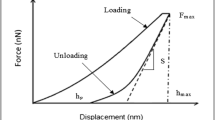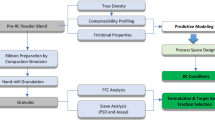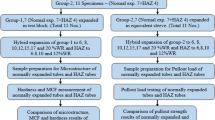Abstract
The aim of this study was to examine the relationship between physical characteristics of compacted ribbons and their thermal effusivity in an attempt to evaluate the feasibility of using effusivity for in-process monitoring of roller compaction. In this study, thermal effusivity, solid fraction, tensile strength, and Young's modulus of ribbons of microcrystal-line cellulose (MCC), anhydrous lactose, and placebo (PBO) formulations containing various ratios of MCC to anhydrous lactose (75∶20, 55∶40, 40∶55, and 20∶75) were determined at various compaction pressures (25–150 bars). The effusivity-square root of solid fraction relationship was linear for MCC and all the PBO formulations but was a second-order polynomial function for lactose. This could be due to the predominant deformation of lactose by brittle fracture, which might have significantly increased the number and size of contact points between particles, causing a change in thermal conductivity along with a density change. The effusivitytensile strength and effusivity-Young's modulus relationships were best described by logarithmic functions for MCC but were linear for lactose up to a compaction pressure of 65 bars. There were similar relationships for effusivity with tensile strength and Young's modulus for all PBO formulations except PBO IV, which might have been due to the deformation of lactose, the largest component in this formulation. Strong correlations between effusivity and physical properties of ribbons were established. Although these correlations were formulation-dependent, they demonstrate the possibility of using effusivity as a tool in monitoring roller compaction.
Similar content being viewed by others
References
Shenoy P. Process analytical technology.Pharm Times. 2004; 36:37–38.
Davis TD, Morris KR, Huang HP, et al. In situ monitoring of wet granulation using online x-ray powder diffraction.Pharm Res. 2003;20:1851–1857.
Balboni ML. Process analytical technology: concepts and principles.Pharm Technol. 2003;27:54–66.
US Food and Drug Administration.PAT—A Framework for Innovative Pharmaceutical Development. Manufacturing, and Quality Assurance, Guidance for Industry. Washington, DC: US Food and Drug Administration, Center for Drug Evaluation and Research; 2004.
Miller RW. Roller compaction technology. In Parikh DM, ed.Handbook of Pharmaceutical Granulation Technology. New York, NY: Marcel Dekker; 1997:99–149.
Adeyeye MC. Roller compaction and milling pharmaceutical unit processes: part I.Am Pharm Rev. 2000;3:37–42.
Falzone AM, Peck GE, McCabe GP. Effects of changes in roller compactor parameters on granulations produced by compaction.Drug Dev Ind Pharm. 1992;18:469–489.
Jerome E, Delacourte A, Leterme P, Guyot JC. The measurement of resulting forces on a roller compactor.Drug Dev Ind Pharm. 1991;17:1571–1591.
Gupta A, Peck GE, Miller RW, Morris KR. Nondestructive measurements of the compact strength and the particle-size distribution after milling of roller compacted powders by near-infrared spectroscopy.J Pharm Sci., 2004;93:1047–1053.
Hakanen A, Laine E. Accoustic characterization of a microcrystalline cellulose powder during and after its compression.Drug Dev Ind Pharm. 1995;21:1573–1582.
Gupta A, Peck GE, Miller RW, Morris KR. Real-time near-infrared monitoring of content uniformity, moisture content, compact density, tensile strength, and Young's modulus of roller compacted powder blends.J Pharm Sci., 2005;94:1589–1597.
Mathews L, Chandler C, Dipali S, et al. Monitoring blend uniformity with effusivity.Pharm Technol., 2002;26:80–84.
Roy Y, Closs S, Mathis N, Nieves E. Thermal effusivity as a process analytical technology to optimize, monitor and control fluid-bed drying.Pharm Technol., 2004;28:21–28.
Roy Y, Mathis N, Closs S, et al. Online thermal effusivity monitoring: a promising technique for determining when to conclude blending of magnesium stearate.Tablets Capsules. 2005;3:38–47.
Zinchuk AV, Mullarney MP, Hancock BC. Simulation of roller compaction using a laboratory scale compaction simulator.Int J Pharm. 2004;269:403–415.
Shapiro M, Dudko V, Royzen V, et al. Characterization of powder beds by thermal conductivity: effect of gas pressure on the thermal resistance of particle contact points.Part Part Syst Char., 2004;21:268–275.
Author information
Authors and Affiliations
Corresponding author
Additional information
Published: March 23, 2007
Rights and permissions
About this article
Cite this article
Ghorab, M.K., Chatlapalli, R., Hasan, S. et al. Application of thermal effusivity as a process analytical technology tool for monitoring and control of the roller compaction process. AAPS PharmSciTech 8, 23 (2007). https://doi.org/10.1208/pt0801023
Received:
Accepted:
DOI: https://doi.org/10.1208/pt0801023




